Lily Iona MacKenzie's Blog, page 54
August 29, 2015
Book Marketing 101 (Part One)
We writers are innocents in many ways, especially regarding the selling side of the publishing business. As long as we can stay in front of our computers, engaged in the dream world of our fictions, we don’t have to think of how these narratives will find their readers. Now that my novel Fling! has been published, I’ve had to make the adjustment. It hasn’t been easy.
Since I was born and raised in Canada, a high school drop out and a single mum when I left and moved to California, I wanted to do my book launch in the land of my birth. My son, who had read my novel in manuscript form and was a great early promoter of the work, suggested I do my first reading at Christina Lake, B.C., where he now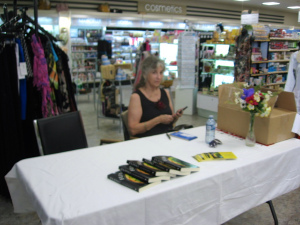 lives. He set up an event at the Living Arts Center and also contacted a nearby library that was interested in hosting me. He even talked to the manager of Pharmasave, a local version of Wal-Mart. She was willing to put my books on display and set aside time one day during my visit for an author-signing session.
lives. He set up an event at the Living Arts Center and also contacted a nearby library that was interested in hosting me. He even talked to the manager of Pharmasave, a local version of Wal-Mart. She was willing to put my books on display and set aside time one day during my visit for an author-signing session.
All of this sounded exciting, but I felt I also needed to include Calgary in my plans, the town where I had grown up. Local girl/woman makes good as debut author. I thought the story might attract potential readers, and I hoped the local papers would interview me (they didn’t). Since one of the novel’s main characters is a feisty 90 year old, I booked readings at the Kerby Senior Center as well as a senior retirement home that caters to ambulatory residents. I also made arrangements for a reading at Page’s bookstore, an independent bookseller that has a good reputation in the city. In addition, CJSW, the University of Calgary radio station, invited me to join the program Suffragette City for an interview. Finally, I registered for the conference that was happening during the dates I would be in Calgary, “Where Words Collide,” hoping it would give me exposure to potential readers through a workshop I offered on “The Origins of Fiction” and a reading I gave there on the last night of the event.
Then I had to make sure these events received copies of my book. But in order to sell them in Canada, I had to apply for a business number and an import/export account. Once I accomplished that, I checked with the venues where I would be reading to see if I could have my publisher mail books so I could reduce the number I would need to carry with me. All except Page’s Books were am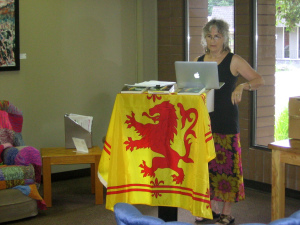 enable. But what I hadn’t anticipated, and nor had they, was the import tax/duty they would have to pay upon receiving the books. In each case, this fee amounted to around $20. Multiplied by six, in addition to shipping charges that I had to pay, it was a costly venture. Clearly, I wasn’t going to be making any money on this tour. It would be mainly for exposure and experience and vanity.
enable. But what I hadn’t anticipated, and nor had they, was the import tax/duty they would have to pay upon receiving the books. In each case, this fee amounted to around $20. Multiplied by six, in addition to shipping charges that I had to pay, it was a costly venture. Clearly, I wasn’t going to be making any money on this tour. It would be mainly for exposure and experience and vanity.
Not knowing what the demand might be for my novel, I also packed about 50 or more copies in our suitcases, almost destroying my husband’s back and ramping up our expenses because our luggage was overweight.
Was all of this effort and expense worth it? While I didn’t sell as many copies of Fling! as I’d hoped to, I did expose the novel to a wider world than the SF Bay Area where I live. I also met a number of people that otherwise might not have attended a book reading/launch and gave them insight into one writer’s world.
Then there are the intangibles. The radio interview I did could have opened doors (and windows) I’ll never be aware of. People do talk about what they see, do, and hear during their days, and I can hope that some might mention Fling!
I also learned a 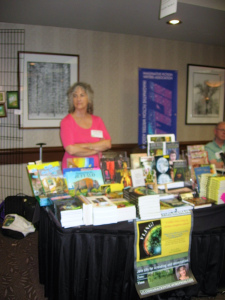 good deal from the tour. I will never again sign up for a writer’s conference unless I know what kind of books are being featured. “Where Words Collide” presented mainly genre books: young adult, romance, mystery, fantasy, sci fi, etc. Those
good deal from the tour. I will never again sign up for a writer’s conference unless I know what kind of books are being featured. “Where Words Collide” presented mainly genre books: young adult, romance, mystery, fantasy, sci fi, etc. Those
who attended weren’t interested in my somewhat conventional magical realism work. I wasted two days there that could have been more productive. It’s also difficult to make one’s book stand out in a sea of books no matter what the genre is. So I’m questioning the value of such events for promoting books in general.
In my next post, I’ll explore what seems to have been my most successful marketing attempts.
Filed under: Links








August 18, 2015
Ariadne’s Daughter
Siren Magazine has published my short story “Ariadne’s Daughter.” It focuses on a young Scottish woman’s attempt to recapture something of herself she lost when she visited Naxos, a Greek Island, as a teenager.
http://www.sirenlitmag.com/latest-pieces/ariadnes-daughter-by-lily-iona-mackenzie
Filed under: Links








August 15, 2015
Book Review: Fling! by Lily Iona MacKenzie
Thanks to Trisha for this lovely review of FLING!
 Originally posted on Slay the Writer:
Originally posted on Slay the Writer:
A wildly comic romp on mothers, daughters, art, and travel…
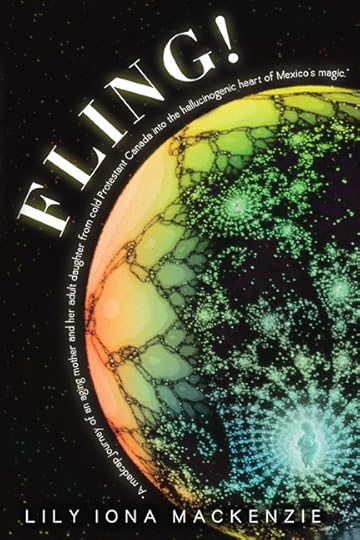 When ninety-year-old Bubbles receives a letter from Mexico City asking her to pick up her mother’s ashes, lost there seventy years earlier and only now surfacing, she hatches a plan. A woman with a mission, Bubbles convinces her hippie daughter Feather to accompany her on thequest. Both women have recently shed husbands and have a secondary agenda: they’d like a little action. And they get it.
When ninety-year-old Bubbles receives a letter from Mexico City asking her to pick up her mother’s ashes, lost there seventy years earlier and only now surfacing, she hatches a plan. A woman with a mission, Bubbles convinces her hippie daughter Feather to accompany her on thequest. Both women have recently shed husbands and have a secondary agenda: they’d like a little action. And they get it.
Alternating narratives weave together Feather and Bubbles’ odyssey. The two women travel south from Canada to Mexico where Bubbles’ long-dead mother, grandmother, and grandfather turn up, enlivening the narrative with their hilarious antics.
Amazon Buy Link: Fling! by Lily Iona MacKenzie
My Review:
When I first read the description of Fling! by Lily Iona MacKenzie, I was eager to start reading. I’m a sucker for complicated mother-daughter relationships and, at its heart, this is…
View original 413 more words
Filed under: Links








August 3, 2015
Meet Vanessa MacLellan who has stopped by my blog to tell me about her debut novel Three Great Lies
Vanessa MacLellan was born and raised in the farmlands of eastern Washington, works as an environmental engineer, and is an avid birder, naturalist, gamer, and runner living in Portland, Oregon. Her website is vanmaclellan.com.
Twitter: https://twitter.com/McCVan
Facebook: http://www.facebook.com/vanessa.maclellan.75
Google+: https://plus.google.com/u/0/113218298408867923612/?rel=author
Vanessa’s debut novel Three Great Lies will be published August 6. Here is what Publisher’s Weekly says about the book:
MacLellan’s fun debut drops Jeanette, an American tourist in Egypt, into ancient Thebes. After she wakes Abayomi, a mummy who’s lost his key to the afterlife, her journey of discovery is filled with danger and thrills. A great sense of character evolution drives the plot, as Jeanette learns that her safe, mundane, passive modern life can’t compare to the active role she takes in freeing Sanura, a child of Bast, from slavery, or working to stop tomb robbing. Her friendships with Abayomi, Sanura, and others form organically, leading to an unlikely but well-handled romantic subplot. Supernatural elements help develop the world around Jeanette, but don’t overpower it. The descriptions feel like what a modern person in Jeanette’s situation would notice, rather than generic scene-setting. A strong conclusion sets this light fantasy a notch above its peers. (Oct.)
http://www.publishersweekly.com/978-0-9892631-4-6
Hi Vanessa Tell us a little about yourself.
I’m a tattooed, vegetarian, outdoorsy woman with one head in the clouds and the other firmly settled in my hiking boots. I’m an environmental engineer by day, author, runner, reader, gamer, naturalist by night (and weekends).
When did you start writing, and why?
When I was a wee lass I’d make up stories to tell my mother while she was gardening. I think it started there. My favorite subject![TGL Cover[2]](https://i.gr-assets.com/images/S/compressed.photo.goodreads.com/hostedimages/1439343943i/15824823.jpg) was Baggy Piggy, who had a curly Q tail that never ended (I knew this, because I drew him incessantly with pink crayons). I remember, before I could even write, ‘writing’ (aka doodling) on paper and then reading them to my great grandmother. Storytelling is in my blood. I guess that’s enough of a reason why.
was Baggy Piggy, who had a curly Q tail that never ended (I knew this, because I drew him incessantly with pink crayons). I remember, before I could even write, ‘writing’ (aka doodling) on paper and then reading them to my great grandmother. Storytelling is in my blood. I guess that’s enough of a reason why.
Though the fact that I enjoy it doesn’t hurt. I have little people in my head (doesn’t every author) that want me to explore their worlds, flesh out their personalities and goals and give them something to do. I can’t take all the credit, it’s partially their fault.
What do you write, and why? What do you enjoy about what you write?
I write speculative fiction. Mainly fantasy, though I mix horror and magical realism in there. I write fantasy because fantasy is what first got me excited about reading. I remember my older sister, Audrey, handing me the first of the Pierce Anthony Xanth novels, and I was astounded at these magical places, characters with magical talents, all of the magical beasts. Magic. Magic. Magic. I wanted that. To live there. Be special. Be something more than just human.
And I read as much fantasy after that as I could. Tolkien, Eddings, Pratchet, Weiss and Hickman, Duncan. You know the era and the authors. That’s what fueled me as a young reader. I hope to fuel other readers too.
And the joy comes from creation and imagination. Of speculating: What if? and expanding from that. I am the master of my own universe, what is not to like?
What is your latest book? Any forthcoming books?
My debut novel, Three Great Lies, releases August 6th. It’s fantasy, with historical and literary trappings. It carries a bit of a Finding My Place in Life theme.
Jeannette Walker, a modern scientist, ends up in ancient, mythological Egypt. Though she constantly casts doubt on the existence of such a world, she has to learn to live in it. While trying to save her mummy friend’s soul from a wicked tomb robbing ring, she realizes a few important things about life. What those are, well, you’ll have to read the book!
I have one complete manuscript for a dark fantasy I’m currently shopping out, and am working on a modern super hero series. There’s always something I’m working on.
Tell us a little about the world of Three Great Lies.
Ancient, mythological Egypt. It never rains. People’s lives aren’t equal. Prayers constantly dance upon lips. Beer is a meal. Sand is a major filler in the bread. Children of gods walk the street with the heads of animals and prophecy on their lips.
To Jeannette it’s, of course, a total shock. There are people about in public naked and jackals speak. A mummy—a desiccated, lumbering thing—chases her through the crowded streets, accusing her of stealing his ba! It’s not necessarily a friendly place, but people are people, and even Jeannette is able to find friends in ways she never expected.
Introduce us to some of your characters. What do you like about them?
Jeannette Walker is my protagonist. She’s mid-twenties, a scientists with a jilted past. She still holds the hurt from a past betrayal and has learned to trust nobody and nothing. I love her voice and her mind-chatter. And she’s got a good heart that struggles to show through her armor.
Abayomi is the dead man walking, a reanimated mummy who seeks his lost ba container so he can continue on to the afterlife. He’s a perfect citizen who knows his place in the world and doesn’t seek to unbalance tradition. Until his friends are endangered, then his loyalty shines like a beacon. True best friend material!
Sanura is the young daughter of Bast, cast out from her litter. She’s lost and alone and Jeannette saves her—saves her—and she’ll never forget such gifts. Sanura, like most young people, is soul-searching, trying to found out exactly why she’s been cast away and what her purpose and place is in life. Her journey is one everyone can connect with. She’s the spirit of the story.
Give us a fun fact you would like your readers to know about Three Great Lies.
A major aspect of the book (the stray dog theme) sprang to life at an agility dog show. The midsummer day was baking hot and I had parked myself under a tree for the next show. A Jack Russell Terrier was looking at me, with that intelligent tongue-lolling smile terriers have. Honestly, the dog was smiling.
And that was the original start of the novel: “The dog was smiling at her.” It’s since changed, but that line and scene are still in there, the theme planted throughout the novel. The story just unfolded from that one dog’s smile and here we are now.
Any challenges with getting Three Great Lies to where it is today?
Three Great Lies has been on a long journey.
In 2008, I wrote my fifth NaNoWriMo novel. That was Three Great Lies. It was titled simply “Egypt” back then. It was a 50,000 word rough draft. Then I added extra plot threads and themes, and it topped out at 140,000 words. That’s quite an addition! Then there were years and years of critiquing and editing.
Finally in 2013, I begin seeking representation for Three Great Lies, and it was picked up by Hadley Rille Books (which was the most perfect place for this book to land).
Now for the rough stuff. As I was due my edits, my publisher had a stroke. (Though he insists he was abducted by aliens to an alternate universe.) It was terrible, we weren’t sure if he would make it. The entire press huddled together in worry and anticipation. I was wavering between feeling devastated for my publisher’s situation and worrying about the state of my book (and feeling so so guilty for that.) But he did pull through and has worked tirelessly on my novel, by my side every step of the way.
Now, we’re here, and my novel is published! I think other authors might have pulled their book to seek other representation, but I knew Hadley Rille and my publisher were perfect for my book.
What’s your writing process?
First and foremost, Three Great Lies was a ‘pantser’ book. I didn’t have an outline. I wrote forward from the smiling dog on guts and intentions. I had this idea of where I wanted to go, with no map on how to get there. Now, I am an outliner. I think the process, for me, would have gone so much faster if I’d had a more solid idea of the substance of the story. As it was, lots and lots and lots of editing and rewriting were necessary to make this book shine.
When I’m in the thick of writing and editing, I try to work on the novel every single day. It keeps my writing sharp and my mind on the storyline. It keeps me from losing plot threads and missing finer details. For me, every day is the way (ooh, that even rhymes.)
And another thing I’ve learned: Do not work heavily on writing in the summer. I like to play outside too much and I feel guilty if I don’t write. Now, I just hold up my hands and let it all go. Summer, for me, is play time. No guilt for taking some time off writing. Because, we’re our worst guilt-trippers.
Blog/site link, and where your book is available.
You can find me at: http://vanmaclellan.com/
http://www.amazon.com/Three-Great-Lies-Vanessa-MacLellan-ebook/dp/B010Y96WTO/ref=sr_1_1?ie=UTF8&qid=1436222042&sr=8-1&keywords=three+great+lies”>You can find Three Great Lies at Amazon
Thanks for answering all of these questions, Vanessa.
Thanks for reading! I hope you come by and check out my site and my novel. It was a joy to write and I hope it brings joy to you as well.
Filed under: Links








July 30, 2015
Rave Reviews for Fling by Lily Iona Mackenzie!
July 27, 2015
The Magic in Magic Realism
 So much has been said about magic realism that it’s difficult to add anything new to the conversation. However, I wondered if putting on my poet’s hat and parsing the two words might crack open another perspective.
So much has been said about magic realism that it’s difficult to add anything new to the conversation. However, I wondered if putting on my poet’s hat and parsing the two words might crack open another perspective.
The term magic implies some slight of hand, an ability to make things appear and disappear at will. In a magic show, magicians exercise their ability to draw viewers’ attention away from what the magicians are doing so they can convince those watching that a rabbit really does appear at random out of an empty hat, or that any number of equally fantastic events can occur. In this case, the magic isn’t really magical in the sense of a supernatural intervention because there’s a trick at its foundation based on perception and how skillful the magician is at keeping the audience distracted enough not to notice the hoax involved.
Something similar happens with writers. They capture our attention through assembling strings of words that become a compelling narrative we follow. Just as a viewer at a magic show sets aside his/her momentary doubts about what’s happening before his/her eyes, so too do readers enter the narrative dream. That enables the writer to convince readers that the setting, characters, and events taking place are actually happening in real time when, in truth, they aren’t. They only come to life in the readers’ imagination as readers let go of their immediate world to undertake this journey into the unknown. Put this way, reading can seem like a potentially dangerous endeavor, and it can be if a writer’s ideas and images shatter some preconceived notion about the world and about us.
Magic also has the ability to temporarily take people out of the constraints of everyday life and make them feel they can transcend it. Instead of being locked inside the usual routines that structure our days, we find release when something magical happens, such as when we watch a play in a theatre and suddenly our world is transformed. We’re no longer our daily selves, but we begin to identify with what’s occurring on the stage and participate in all of the characters involved, good guys and bad guys. We’re under the actors’ and director’s spell, convinced that the action unfolding in front of us is real, though it’s only make believe.
From these examples I’ve given, it’s easy to see that any writing, whether it’s a novel or a play, has a magical component to it. Words themselves are transformative in that they can so easily metamorphose into other words: world contains word and old. Add or subtract a letter here or there and we’ve landed in a different meaning. Words in themselves are slippery and magical, calling forth images just by naming things: red chair, oak table, 2006 Honda Accord, green plaid coat, eucalyptus tree. Read the text and suddenly something appears in our mind’s eye. Amazing!
And then there’s the way the wind can blow open a door, filling the house with a gust of cold air, or the sun can illuminate a field and immediately transform our experience of that place. Or the timer on our living room lamp switches on silently and the room is now swathed in light, creating a totally different atmosphere. That’s one reason we talk about something magical happening, or of a place as being magical. In fact, the world is magical not only in its inherent changeability but also because of our interaction with it.
That’s where “realism” enters the discussion. Reality is both magical and “real,” if by real we mean something that isn’t imagined. I’m not a philosopher, but this computer I’m typing on has a life distinct from mine. My husband, who is sitting reading in a chair across from me, can see it and agree on its reality. But it also exists in a world where objects can become symbols for something else, so while my computer retains its identify as a writer’s tool, it also can represent a window into another universe. It can become a metaphor for many things, just as most objects can.
This, then, seems to be the foundation for what we call magic realism. Language by its very nature is magical, transforming our everyday reality in multiple ways, carrying us aloft on the wings of thought.
This post is part of the Magic Realism Blog Hop. About twenty blogs are taking part in the hop. Over three days (29th – 31st July 2015) these blogs will be posting about magic realism. Please take the time to click on the button below to visit them and remember that links to the new posts will be added over the three days, so do come back to read more.
Filed under: Links Tagged: magic, magic realism, magical realism








July 20, 2015
Women On Writing (WOW) Blog Tour Dates for Fling!
Crystal Casavant-Otto has organized a lively blog tour featuring me and my novel Fling! If you’re available on the following dates, please check in! There are several opportunities to win a 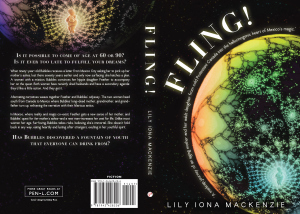 free copy of the book.
free copy of the book.
Monday, July 27 @ The Muffin
Stop by for an interview and book giveaway!
http://muffin.wow-womenonwriting.com/
Tuesday, July 28 @ Choices
“Poetry and Perception” is the topic today at Choices by Madeline Sharples. Read this insightful guest post by author Lily Iona MacKenzie and find out more about her latest novel “Fling”. One lucky reader will also win a copy of their own to enjoy!
Wednesday, July 29 @ Selling Books
Find out what Lily Iona MacKenzie has to say about writers groups as she stops by the blog of Cathy Stucker. MacKenzie’s debut novel “Fling” is quickly climbing the charts, you won’t want to miss a moment of this exciting book blog tour!
Friday, July 31 @ Ava Louise
“Writing Memoir” is the topic at the blog of author Ava Louise. Thank you to fellow author Lily Iona MacKenzie for this fabulous guest post. Reader can stop by and learn more about this topic as well as MacKenzie’s debut novel “Fling”.
Monday, August 3 @ Bring On Lemons
Crystal Otto reviews “Fling” by Lily Iona MacKenzie. Don’t miss this review as well as a giveaway to win your own copy of this debut novel.
http://bringonlemons.blogspot.com/
Tuesday, August 4 @ All Things Audry
Join fellow author Audry Fryer as she reviews “Fling” by Lily Iona MacKenzie.
http://allthingsaudry.blogspot.com/
Wednesday, August 5 @ MC Simon
Lily Iona MacKenzie shares insight about “Writing Like an Architect” as she writes the guest post for Mc Simon Writes. Find out more about this topic as well as MacKenzie’s debut novel “Fling”
Thursday, August 6 @ Kathleen Pooler
Join Lily Iona MacKenzie as she writes about “”Timing and the Creative Process” as the guest author at Kathleen Pooler’s Memoir Writer’s Journey today. Learn more about MacKenzie and her debut novel “Fling”
Saturday, August 8 @ Hott Books
Today’s guest author at Hott Books is Lily Iona MacKenzie with a guest post about revising your writing. Learn more about this topic as well as MacKenzie’s debut novel “Fling”.
Monday, August 10 @ Create Write Now
Don’t miss today’s guest post at Mari McCarthy’s Create Write Now. The topic is: “Writing as a Spiritual Path and an Exercise in Trust” written by Lily Iona MacKenzie as part of her book blog tour for her debut novel “Fling”
http://www.createwritenow.com/
Tuesday, August 11 @ Lisa Haselton
Lily Iona MacKenzie authors today’s guest post at Lisa Hasleton’s blog. Don’t miss this topic of “Blogging” and find out more about MacKenzie’s debut novel “Fling”
http://lisahaseltonsreviewsandinterviews.blogspot.com/
Friday, August 14 @ Slay the Writer
Fellow author Trisha Slay reviews the debut novel “Fling” by Lily Iona MacKenzie
Filed under: Links Tagged: blog tour, book giveaway, fling, Women on Writing, WOW








July 16, 2015
Becoming a Butterfly
My husband and I just returned from a month in Italy. It felt as though not only were we transported to another continent, but we also lived in a cocoon for that period of time. We ignored the news. We focused mainly on our new environment, immersed in the cultural differences, trying to become Italian for a short while at least.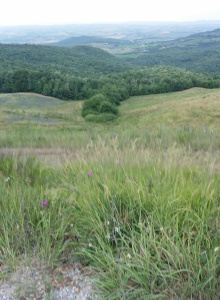
When I think of cocoons, of course, I think of butterflies and the phases they go through in their evolution. The cocoon or chrysalis stage prepares them for the fourth and last stage.
Okay, I’m not going to imply that we returned from our vacation as butterflies, but I do think these trips offer us a chance to revise ourselves and bring back something of the culture(s) we visited, depositing whatever we’ve learned or discovered in our home environment.
The loveliest thing about being in transit was letting go of our usual routines and schedules. I didn’t go to the gym or work out regularly (except for climbing the endless number of stairs wherever we went). I didn’t meditate. I didn’t prepare meals except occasionally. 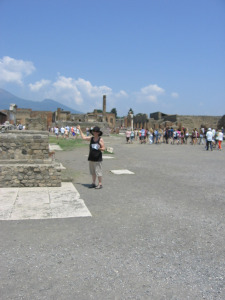 I let go of my daily practices, and that allowed another mentality to take root.
I let go of my daily practices, and that allowed another mentality to take root.
Will I be able to sustain this alternative way of being? Only time will tell. At the moment, I can’t stand to turn on CNN or any other 24/7 news channel. I long for a ride on a vaporetta. I even miss climbing so many stairs. Naturally there’s much more that I had to leave behind: the wonderful restaurant we found in Venice with the frenetic owner who also was the waiter. He did a dance for hours as he flitted between tables and kitchen, all contained in the same room (CoVino). The ancient sites with their echoes of former centuries (Pompeii was particularly disturbing and moving: to think that in an instant a culture was decimated) . The stunning Tuscan landscape that not even our Northern California hills can match.
Clearly, these memories will be working on me for a long time, and while I might not become a butterfly, I at least know what I’m missing.
Filed under: Links Tagged: butterfly, cocoon, CoVino, florence, italy, pompeii, tuscany, venice








July 8, 2015
Viva Quebec City!
I’ve just returned from touring some of Tuscany’s scenic hill towns—Pienza, Montalcino, Montepulciano, Sienna, and others. While they are distinctive sites and well worth visiting, I find my Canadian nationalism surging, and I want to write about Quebec City, not about Italy.
It’s difficult to find a place that equals Quebec City for its charm, unique culture, and beauty. The only walled city north of Mexico, when you pass through the portal into the city’s historic section, the focus for most visitors, it’s like entering a fairy tale complete with a castle. The century-old Fairmont Le Château Frontenac—with its towering top ringed by steeples and turrets—overlooks the St. Lawrence River and soars over the town, adding to the magical feeling.
But this impressive hotel hasn’t always dominated the old city. Many museums, c hurches, homes, and scenic lanes date back to the 1600s. These are the structures that define QC and give it so much charisma. The Frontenac is the icing on the cake.
hurches, homes, and scenic lanes date back to the 1600s. These are the structures that define QC and give it so much charisma. The Frontenac is the icing on the cake.
Quebec’s Upper Town (Haute-Ville) is perched on cliffs overlooking the St. Lawrence River and provides views of the countryside for many miles beyond. Accessible by steep stairs or via a funicular car, Old Quebec’s Lower Town has its own historic charms. The Basse-Ville sprang up around the city’s harbor and was the original neighborhood of the city. Homes, shops, and ancient streets sprawled here at the base of the cliffs centering around Place Royale—a square on the site of the garden of Champlain’s Habitation (1608).
The preferred entry to old Quebec City is via the Grande Allee. Time seems to have stood still here. It’s like entering another world, another time, another place, and it works its magic on you. Only Rottenburg, another walled city, has had such an effect on me.
A horse drawn cab is the appropriate way to view this wonderful place. When we visited, our driver was a redhead, of Irish descent, but born and raised in Quebec. He spoke very clear English, his words carefully enunciated. He wore a straw hat, and the horse’s name was Dixie. We learned that the animals aren’t overworked. A vet checks them every day, and they only pull a carriage every other day.
On our fire-engine red cab, we wove through narrow cobblestone streets past stone houses festooned with window planters. In the more commercial area, the vividly colored umbrellas at sidewalk cafes competed with the flowers for lending bright patches to the scenes. We also passed the Hotel Clarendon, built in 1870, where we stayed. It’s the oldest hotel in the walled city. Located a little away from the most festive streets, it’s still in the center of the action. Our room had a window overlooking the St. Lawrence, a clock tower, a part of the Château Frontenac, and a park.
If I can generalize, this link between French and English speaking Canada that our driver represented captures the essence of Canada, with Ottawa the head and Quebec City the heart. Without Quebec, something precious would be lost to Canadians. It’s a touchstone and, Quebec City, which lost once to the British, must not lose again. It has the exuberance, the emotional life, and the sensuality that some Anglos can lack. Quebec City also is the heart in that the Americas emerged out of European sensibility, and that presence its felt here perhaps more than anywhere else. I guess that’s why Italy’s hill towns and QC merge for me.
Filed under: Links Tagged: canada, italy, quebec city








July 4, 2015
My first review of Fling!
All writers need reviewers for their books so others can decide whether to read them or not. The review offers a perspective that some readers need before they invest in a novel. That’s why I’m pleased to post my first official review of Fling! by a reader I don’t know. In other words, it’s what’s called an honest review.
If anyone else is interested in reading and reviewing Fling!, I can give you a copy, free, in whatever format you prefer (paperbook or pdf) in exchange for your honest review.
N.N. Light’s has posted the review on her blog, on Amazon, and on Goodreads. I’m also including it below for those who are interested. https://princessofthelight.wordpress.com/2015/07/02/fling-by-lilyionamac-bookreview-literaryfiction-mexico/
The relationship between mothers and daughters has always been a complicated one, ripe with misunderstandings, love, betrayal, virtue, honesty and jealousy. In Fling, we delve into three generations of women, all looking for answers.
Bubbles receives a letter from Mexico saying they are holding her mother’s ashes and please come pick them up. She calls her daughter, Feather, and convinces her to go to Mexico. Feather, not knowing how long her mother has left, agrees.
What started out as a favor to her mother, turns Feather’s world upside down. There’s something magical about Mexico (old Mexico, I mean) and all three generations of women discover the spirit within.
A beautifully told story, we catch a glimpse behind the scenes through flashbacks. Normally, flashbacks are a pet-peeve of mine but I wasn’t bothered because I felt I was part of the story. I was enthralled by the narration as I got deep into each of the characters. Art, myth and the lure of Mexico blend perfectly in Fling.
Favorite Character: Bubbles was my favorite character because she reminded me of my great-grandmother. She’s a free spirit and has lived three lifetimes in one. She may appear to be enigma to her daughter, Feather, but to me, she is a woman after my own heart. Fun, feisty and flirty, Bubbles will steal your heart.
Favorite Quote: Like a snarl in Annie’s knitting, she’s waiting to be untangled and rewoven into the fabric, freed from the negative family stuff but not separated from kin. ~Feather
Filed under: Links 









![vanessa photo small[2]](https://i.gr-assets.com/images/S/compressed.photo.goodreads.com/hostedimages/1439343943i/15824822.jpg)











